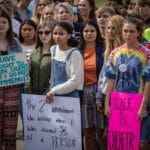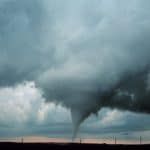Looking clearly at right-wing terrorism
By Charles P. Blair | June 9, 2014
Five years ago the US Department of Homeland Security’s Homeland Environment Threat Analysis Division released an assessment of US far-right extremism. Initially intended for law enforcement and intelligence agencies only, the report—“Rightwing Extremism: Current Economic and Political Climate Fueling Resurgence in Radicalization and Recruitment”—was almost immediately leaked. The report warned that small cells practicing “leaderless resistance” and “white supremacist lone wolves [posed] the most significant domestic terrorist threat.” Significantly, it highlighted the likelihood of expanded attempts by far-right extremists “to recruit and radicalize returning veterans in order to boost their violent capabilities.” Overall, the report warned of trends similar to “the 1990s when rightwing extremism experienced a resurgence.” That far-right extremist rally reached a violent crescendo with the bombing of the Alfred P. Murrah federal building in Oklahoma City on April 19, 1995.
Reflecting on the past five years, a leading far-right extremism expert I recently interviewed described the homeland security report as “prophetic.” Mark Pitcavage, the Anti-Defamation League’s director of investigative research, explained that most of the warnings in the 2009 report have become realities. Yet at the time of its release, the document was derided by many inside and outside of government as “ridiculous [and] deeply offensive,” an “inconceivable” assault on US veterans, and, in general, “a piece of crap.” Buckling under political pressure from conservatives, homeland security rapidly repressed the report. Promptly removed from department’s website, the tabooed document also disappeared from the computer systems of state and local law enforcement divisions as well as federal intelligence agencies. The homeland security unit responsible for the report was virtually muzzled. The report essentially fell into obscurity.
The report’s demise was an unfortunate loss for all levels of law enforcement. Since its release, credible plots and attacks by violent extremists have surged. As the report forewarned, responsibility for the vast majority of these events lies with far-right individual extremists and extreme groups. Moreover, veteran and active-duty military personnel, when compared to the general population, were disproportionally involved in far-right extremist incidents. In just the first two months following the report, significant attacks occurred via the hands of major components of far-right extremism. For example, in May 2009, a “soldier” in the Christian terrorist anti-abortion network Army of God assassinated Kansas late-term abortion provider George Tiller. One day earlier, members of an anti-immigrant vigilante group—the Minutemen American Defense—invaded the home of an Arizona Latino and his 9-year-old daughter. Both were killed as part of a plan aimed at securing money to fund the group’s anti-immigrant terrorist operations. Less than two weeks later an octogenarian white supremacist shot and killed a security guard at the US Holocaust Memorial Museum. Reflecting the conspiracy theories adhered to by many white supremacists, hand-written notes found in his car read, “The Holocaust is a lie… Obama was created by Jews… Jews captured America’s money. Jews control the mass media.”
In the five years following the report’s release, far-right extremists have also plotted against and, at times, successfully attacked a wide-range of additional targets, including government buildings and leaders, law enforcement personnel, polling stations, courthouses and judges, a Martin Luther King Jr. Day parade, anti-racist gatherings, a Mexican consulate, synagogues and other Jewish institutions, mosques, a Sikh temple, African-Americans and other minorities, and interracial couples and families.
Despite this grim record—amid a political environment that often discounts warnings of far-right extremist threats and terrorism—the Department of Homeland Security remains reluctant to address the growing threat. One of the 2009 report’s primary authors noted that since “our report was leaked, DHS has not released a single report of its own on this topic. Not anything dealing with non-Islamic domestic extremism—whether it’s anti-abortion extremists, white supremacists … the whole gamut.” Only very recently have reports been released by the unit in question; the few that address far-right extremism do so parsimoniously and with clear caution.
Far-right terrorism in the US is more common than other types of violent radicalism. A recent study by the New America Foundation found that since 9/11, far-right extremists “have killed more people in the United States than have extremists motivated by al Qaeda’s ideology.” And perhaps most important, far-right terrorists are more prone to seek unconventional weapons—that is, weapons that might generate mass casualties or mass disruption. The study found that while no “jihadists indicted or convicted in the United States” had obtained or employed chemical or biological warfare agents, 13 individuals motivated by far-right extremist ideology, “acquired or used chemical or biological weapons or their precursor materials.” In the recent past, far-right extremists have also plotted the use of radiological weapons.
The threat of major acts of far-right terrorism—perhaps aided by people with military training—is real. It should not be exaggerated, but neither should it be suppressed for political or ideological reasons.
New rise of the far right. For almost 15 years after the Oklahoma City bombing, far-right extremism remained a relative constant; now it has risen again in group numbers, violence, and latent explosiveness. To gain greater clarity on this alarming trajectory, I recently spoke with Mark Potok, an expert in domestic extremism and director of the Southern Poverty Law Center. Addressing the numerical ebb and flow with far-right “hate groups” (that is, US white supremacist and other groups whose beliefs or practices attack or malign an entire class of people), Potok said, “What we’ve been seeing is a long slow steady rise since 2000—it has gone from 602 groups that year to 1,007 groups in 2012.” The rise was connected to the election of an African-American president and accompanying conspiracy theories, Potok explained; a severe economic recession and fears related to immigration also were factors.
This expansion of hate groups has been paralleled by growth in the number of “patriot groups” (defined as US militias and other strongly anti-government related groups that are not primarily white supremacist or racist in orientation). The Southern Poverty Law Center’s count of such groups initially peaked in the mid-1990s, at 858. A steep decline ensued, especially after the so-called Y2K bug—the potential mass demise of computers made before the year 2000—failed to bring about societal chaos, rapture, or a millenarian apocalypse. In 2001, the movement hit its nadir with 150 groups and remained low throughout both of President George W. Bush’s terms.
But in 2009, Potok said, “[t]he patriot group numbers began skyrocketing. By 2011 there were 1,274, and in 2012 the numbers peaked at 1,360.”
The numbers of both hate and patriot groups slightly declined in 2013—by 7 and 19 percent respectively. In addition to an improved economy and law enforcement crackdowns, Potok attributed the recent decline to two primary factors: the reelection of President Obama, which “really took the sails out of the radical right,” and mainstream politicians’ cooption of far-right causes. Potok’s observations were echoed in a recent interview I conducted with Randy Blazak, a Portland State University sociology professor and a widely noted expert on far-right extremism, who says that a lot of extremist group members, “found a home in the Tea Party. It siphoned rank and file anti-government, anti-immigrant, and anti-Semitic types.”
But group numbers for far-right extremism are only part of the threat equation. Since at least 1978, individuals have perpetrated the majority of terrorist attacks in the United States. Moreover, according to a researcher at the US Naval Postgraduate School, “since 9/11 60 percent of domestic lone-wolf attacks have been perpetrated by those holding right-wing ideologies.”
With far-right extremists, the concept of “leaderless resistance” came to the fore in the early 1980s. It was developed primarily by a pioneering member of the neo-Nazi organization Aryan Nations, Louis Beam, a one-time member of the Knights of the Ku Klux Klan who wrote and circulated a collection of influential essays evaluating the Klan’s history, strengths, and weaknesses. Beam’s most crucial composition, written in 1983 and titled “Leaderless Resistance,” abandoned any notion that hierarchical violent groups could effectively advance the far-right extremist struggle and restore “a White Christian Civilization.” Rather, he argued that individuals and small cells offered the only way forward in reclaiming the country from “subhumans,” the “anti-Christ Jew” and, above all else, “race traitors.” With leaderless resistance, Beam wrote, “all individuals and groups operate independently of each other, and never report to a central headquarters or single leader for direction or instruction … [insuring] no single opportunity for the (“scalawag”) Federals to destroy a significant portion of the Resistance.”
While some white supremacists argue against leaderless resistance, Beam’s treatise gained significant acceptance in the fringes of extremist communities, largely because there is virtually no safe place in the United States for far-right extremist groups to organize and maintain operational security while planning an attack.
In some ways the ascendancy of individuals over groups is a positive development. Single persons almost always have fewer operational capabilities and resources than groups when it comes to large-scale attacks. But individuals can present profound challenges to law enforcement. Susceptibility to impulsive behavior means less time for authorities to discern and apprehend individuals prior to an attack. Individual extremists also tend to be less constrained by moderating voices than those in groups.
Lowering numbers also represent other dangers. Blazak told me that when such groups downsize, often the most committed members feel as if they have lost their only home. “Their movement is lost to them,” Blazak explained. “They get increasingly frustrated and sometimes go out in a blaze of glory.” Evidence for this assessment abounds in far-right extremists’ encounters with law enforcement. Between January 2009 and December 2013, Pitcavage said, there were 43 reported encounters in the United States between police and extremists in which shots were fired—the vast majority of them shootouts. Of the 43 incidents, 38 were tied to far-right extremists, with 17 incidents involving people holding extreme anti-government views and 21 involving white supremacists.
The military and the far right. Throughout the history of US far-right extremism, many of its most influential and infamous members have had ties to the military. A small sampling includes the former Confederate soldiers who founded the Ku Klux Klan in 1866; its first leader was a former Confederate general, Nathan Bedford Forest. The highly influential Willis Carto served in World War II before a 50 year career with far-right extremism that encompassed, according to the Anti-Defamation League, “nearly every significant far-right movement in the country, from neo-Nazism to militias, segregationism to Holocaust denial.” An aide to General McArthur, William Potter Gale, oversaw guerilla resistance in the Philippines during World War II before helping establish the racist, anti-Semitic, and apocalyptic Christian Identity movement and the virulently anti-federal government umbrella organization Posse Comitatus. The North Dakota Posse leader Gordon Kahl, who died in a 1983 shootout with federal agents, and whom many far-right extremists consider to be the Posse’s greatest martyr, earned two purple hearts as an aircraft gunner in World War II. Aryan Nations founder Richard Butler served in World War II.
The trend has continued in more recent years: Neo-Nazi Louis Beam was a Vietnam veteran. The founder of one of the leading racist groups of its time, White Aryan Resistance, Tom Metzger, spent the early 1960s in the US Army. Metzger is often credited with being the “godfather” of the racist skinhead scene. Timothy McVeigh, whose actions during Operation Desert Storm merited him the Bronze Star, later killed 168 people, including 19 children in the 1995 Oklahoma City truck bombing; his accomplice, Terry Nichols, was also a veteran. Army of God adherent and Centennial Olympic Park and abortion clinic bomber Eric Rudolf was an Army veteran. In August 2012, Army veteran Wade Michael Page killed six people in a racially motived shooting rampage at a Wisconsin Sikh temple. Radicalized during his time at Ft. Bragg, Page told an interviewer, “If you don’t go in the military a racist, you’re sure to leave as one.”
To be clear, the homeland security department’s 2009 report on far-right extremism did not denigrate US military personnel or exaggerate their past or potential for terrorism. Many studies and reports demonstrate that veteran and active-duty US military personnel account for only a miniscule part of far-right extremist plots and attacks. But the percentage of individuals and members in far-right groups with military experience is larger than the corresponding percentage of those with military experience in the population at large. And in a 2008 study, the FBI reported that veteran and active duty military personnel “frequently occupy leadership roles within extremist groups …[T]he military training veterans bring to the movement and their potential to pass this training on to others can increase the ability of lone offenders to carry out violence from the movement’s fringes.”
The veterans issue precipitated a political backlash against the 2009 report on far-right extremists’ potential for terrorist acts. In one of many examples of the backlash, US Rep. Lamar Smith (R-Texas) argued that in contrast to the 2009 report, an earlier homeland security report had identified “actual” extremists and terrorists, “like the Earth Liberation Front and the Animal Liberation Front.”
Congressional leaders would be wise to exclude politics from their assessments of Department of Homeland Security reports. As a matter of documented fact, far-right extremists appear to pose the greatest existing terrorist threat to the United States. The danger manifest by extremist terrorism is not a linear one; as Potok observed, it ebbs and flows. But one thing is certain: Events can catapult a red-hot movement into a white-hot violent crisis. Far-right extremist leaders literally declared war on the federal government after the horribly botched events at Ruby Ridge, Idaho in 1992 and, a year later, the disastrous siege of the Branch Davidian compound in Waco, Texas. Two years to the day after the latter incident, Timothy McVeigh unleashed his bomb in Oklahoma City.
The recent Nevada standoff between rancher Cliven Bundy and federal authorities is in one sense just a continuation of Sagebrush Rebellion behavior that has come and gone in the Mountain West for decades. It also offers a window into the thinking of a group of far-right “patriots,” and an opportunity to ponder how governmental miscalculation might inflame others, at distant times and places. The nation faces many threats; one of them is far-right extremism and its propensity for violence. Suppressing discussion of that threat will not lessen it.
Editor’s note: Along with several other experts, Charles Blair will lead a short-course on terrorism at George Mason University on July 14-16. Open to government analysts and the public, the course will examine evolving technologies, strategies and tactics, radicalization, counterterrorism strategies, red teaming, and case studies of terrorist groups, including far-right extremists.
Together, we make the world safer.
The Bulletin elevates expert voices above the noise. But as an independent nonprofit organization, our operations depend on the support of readers like you. Help us continue to deliver quality journalism that holds leaders accountable. Your support of our work at any level is important. In return, we promise our coverage will be understandable, influential, vigilant, solution-oriented, and fair-minded. Together we can make a difference.
Topics: Columnists















